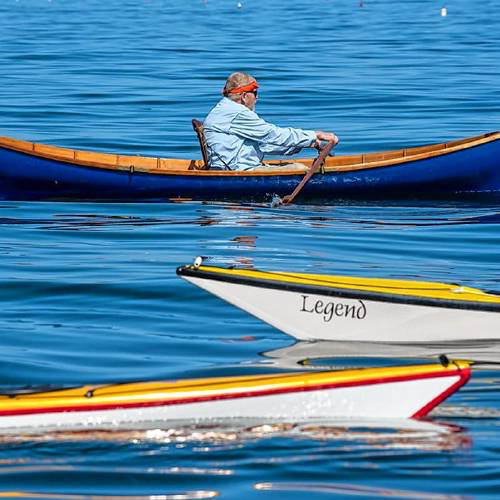A Yankee Notebook
NUMBER 1936
August 27, 2018
A Trail of Islands
EAST MONTPELIER, VT – Summer on the coast of Maine is described best as summer in Vermont on anabolic steroids. The combination of commercial vans, semitrailers, RVs, local traffic, and SUVs loaded down with kids, kayaks, and bicycles, all traveling at between 75 and 88 miles per hour, is a bit daunting for an old fossil like me. I love to drive, but the constant need for vigilance was taxing. Nevertheless, I successfully followed the written directions of two long-ago Outward Bound associates to their home near Portland, hypoed down on a jigger of Scotch, and dined on the veranda by candle- and moonlight on barbecued lobster tails and flank steak. The perils of the following morning’s resumption of the automotive dash down east faded away.
But – mirabile dictu – at breakfast, my friend was able to take my under-exploited phone and type in the directions to my destination. So, even though the lady in the phone spoke a bit softly for my elderly ears, she and I managed to get to the boat landing at the Dolphin Restaurant in Harpswell ten minutes before I was due. The traffic had died away just outside Brunswick, so the drive, past classic old shingled Capes, was as calming as the previous evening’s Glenmorangie.
The crew was already there, sorting through the usual jumble of wires, cables, cameras, batteries, and microphones. There were three other men there, staff or friends of the Maine Island Trail Association, who were to accompany us to one of the islands in the long chain of them in the trail. One had brought a big Boston Whaler for the crew; the two others carried their ocean kayaks – long, sleek hulls no wider than a man’s bottom – down to the water’s edge.
I was supposed to paddle with them, but had chickened out. My kayak is fast enough, but it’s not an ocean boat, and my kayak skills are barely journeyman. So I’d brought my lovely Adirondack guide boat, over the skeptical remarks of the producer, who doubted that a “rowboat” could keep up. The kayakers were clearly wowed – as they’d ought to have been; it’s the Stradivarius of small craft – and carried it reverentially down to the shingle for me. A few minutes later, once we’d gotten it into the water, they lowered me into it (I can’t get in or out anymore without help), and we paddled softly out of the harbor.
I’d been a bit concerned that the sea might be rough or high, as the boat is best on mountain ponds and smooth rivers. Also, facing backwards, I can’t see where I’m going. But over a relatively glassy sea, and with a kayak on each side, we clipped right along. The only hitch in our gitalong occurred when the crew, snug in the Whaler, encouraged one of the kayakers, a Harvard physics professor, to surf a wave breaking on a ledge. I watched from a safe distance, while a harbor seal played peekaboo with me, thinking, “This may not end well,” as the professor gave it a try and his boat reared up into the air.
It did not end well. So we skipped a visit to Admiral Peary’s cottage on Eagle Island and headed straight for Jewell, where I remember camping on the beach with an Outward Bound group over 50 years ago. We had some lunch, rehydrated, walked about a bit, and talked on-camera about the Island Trail.
It’s one of those inspired ideas that in its particular niche counteracts the mechanization of crowded natural resources. It stretches all the way from Kittery, on the New Hampshire border, 375 miles to Eastport, on the Canadian border. There are over 200 wild islands in the chain, and, though there’s a guidebook, no prescribed way to get from one to another. Members of the association practice no-trace camping and try to leave places better than they found them. Thus, non-resident owners of islands, upset at trash left by picnickers, are assured of an improvement in the appearance of their shorelines. Agreements to use the islands are by handshake, and subject – either by addition or subtraction – to change, so the Association publishes annual updates to the guidebook. It was easy to decide to come back.
While we chatted on the beach, several boats putted into the beautiful cove of the island. Some of them bore campers, who came ashore andmheaded into the woods above the bluff looking for campsites; others parked at the edge of the water while their owners set up lawn chairs and picnicked; and one large, old-fashioned catboat looked as though it was anchored for the night. As we prepared to leave, the producer who’d sneezed (albeit politely) at my “rowboat” asked if he could row it back to the harbor. Concealing my delight – my rear was pretty sore from the trip out – I allowed reluctantly as how he might.
We got back to shore mid-afternoon, so I decided to try to make it home that night. Instead of braving the crazinesss of interstate travel, I’d cut cross-lots to Conway and Crawford Notch. After 30 miles of stop-and-go traffic (cheering each commuter who turned into his driveway ahead of me!), I almost repented of the decision; but just before dark the road opened up, and I could again see the hills of home.


